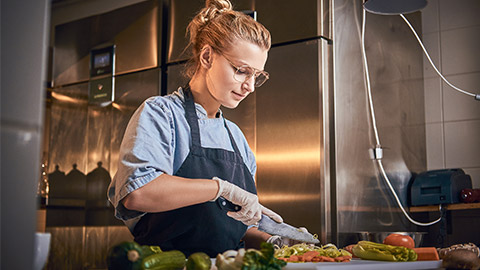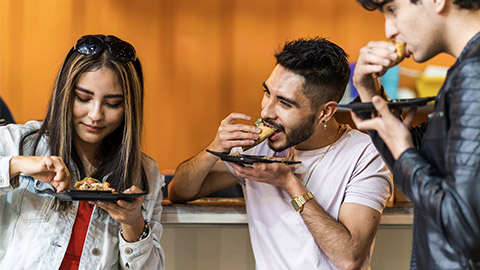Continuing on from Lesson 5, we’re going to consider the specific impact of the internet on restaurant operations.
Exercise 4
Find one example of how the internet has been utilised by a specific commercial hospitality organisation for each of the four examples mentioned in the previous lesson (websites, online review sites, food blogs and smartphones).
- Examine its impact and make notes on how the technology can be used to improve what a food busines does, or any other way it impacts on a food business.
- Save links, screenshots etc. as a record of what you have found out.
- Now make a Power Point or Microsoft Sway that outlines your findings and upload it to share with your classmates.
Self-Directed Learning
Complete Exercise 4.
Find examples of hospitality operations effectively utilising Social Media to be used in Assessment Task 2, Part 1.
Most restaurants and food businesses use a variety of social media platforms, as well as the internet, to their advantage. They are now an essential way to communicate with customers in order to provide essential information, but they are equally important in promoting and marketing a food business’s message.
One example of how a modern restaurant has used a variety of different online platforms to deliver its message and communicate with its customer base is Silo in London.
Silo Concept
Silo is a great example of a modern food business, which is responding to customer trends and requirements for the 2020s. They state their aim is to
innovate the food industry whilst demonstrating respect…for the environment… for the way our food is generated…for the nourishment given to our bodiesSilo: Our Story, n.d.
Minimising wastage is a huge trend, not only in food, but in most areas of modern life, with many people conscious of the need to conserve resources and reduce excess consumption (Taylor, 2020) and Silo is one of the world’s foremost zero-waste restaurants. They use everything to its maximum potential, to the point where they have their restaurant plates made from upcycled plastic bags and make their dining room furniture from pallets and other reclaimed materials.
Communicating their key point of difference as being a restaurant committed to reducing or eliminating waste is an important part of their success, and Silo has marketed this message through various social media and online platforms to reach as wide an audience as possible. In this way they are able to form a community of people who share their beliefs and interests, and who enjoy their style of food.
Website

www.silolondon.com is used as a source of information about the restaurant. It contains the history of the zero waste restaurant movement and the story of how Silo began and how it operates.

The website contains other information customers would require if they wished to dine at Silo:
- Physical address with Google map showing precise location.
- Contact details – phone number, email addresses, enquiry/contact form.
- Newsletter sign up.
- Opening hours.
- Online booking form.
- Links to social media accounts: Twitter, Facebook and Instagram.
It is a great visual way to get people interested in the restaurant – creating a curated Instagram feed to add their own content. The advantage of using social media platforms such as Instagram is that they can be kept very up to date.


Instagram Hashtags
Hashtags are key words used to cross-reference content uploaded by multiple users with the same theme. In this way Instagram images with a common idea can easily be found, and it is a way for restaurant customers to be able to share their images of that restaurant.
Silo uses the hashtag #silolondon for customers to upload their own images, which helps to generate a community spirit. They also use hashtags relevant to their story – e.g. #sustainabilty #zerowaste #zerowasterestaurants which helps people who share similar interests to their feed and then to their website.


Instagram Stories
This is another way of engaging with customers in a 15 second video which disappears after 24 hours. They are great for showing what’s going on in the restaurant – cooking a dish, behind the scenes etc.
Other Social Media
Twitter and Facebook are used to communicate instantly with their followers – specials, daily menus, stories etc are good examples of keeping customers informed and the restaurant top of mind for bookings.


Streaming Media
YouTube and Vimeo are also useful to explain in much more detail the story of the restaurant and show the personalities and behind the scenes stories.


Exercise 5
Now it’s your turn: using the Silo Case study, profile another restaurant. Make notes in your journal.
Self-Directed Learning
Continue with research and planning for Social Media section of Task 2. Find and summarise examples.
Modify Task 1 as indicated by your tutor in the feedback to Checkpoint 1.

Where does our food come from? How is it produced/made?
Watch the videos:
What does “production” mean?

Exercise 6
Consider these definitions of the word “production” and how they apply to food. Think about how food gets onto your plate – what stages are there in the process? Draw a detailed diagram in your journal detailing how a product of your choosing arrives on your plate.
Self-Directed Learning
Complete Social Media section of Task 2.
Prepare for Part 2 of Task 2 (Food Production) by watching videos on technology and ethics linked to in the Student Resource and any other relevant sources.

What are food production systems?
Food Production Systems map the journey of the food we eat through the stages of commodity production à transportation à consumption.
(Food Systems: Environments, Production, Distribution, and Household Utilization of Food | GEOG 3: The Future of Food, n.d.)
For this study, we can look at how the food we serve to our customers got to be there – how it was grown, transported and processed to be ready to be prepared in our food business kitchens. Clearly, there are many stages and processes in this chain, and each one has had significant development over the years.
Significance of developments in food production systems
The Food and Agriculture Organisation of the United Nations (FAO) states:
“A range of pressures including rapid population growth, urbanisation, growing wealth and consequent changes in consumption patterns, are challenging our food systems’ ability to provide nutritious food, and to contribute to enhanced livelihood opportunities in an environmentally sustainable way. Our food systems are contributing to, and affected by, extreme weather events as associated with climate change, land degradation and biodiversity loss. Responding to these challenges requires a systems-based approach that addresses the range and complexities in a holistic and sustainable manner.
A sustainable food system is one that delivers food security and nutrition for all in such a way that the economic, social and environmental bases to generate food security and nutrition for future generation is not compromised. This means that it is profitable throughout, ensuring economic sustainability, it has broad-based benefits for society, securing social sustainability, and that it has a positive or neutral impact on the natural resource environment, safeguarding the sustainability of the environment. (FAO, n.d.)
The aim of developments in food production systems should be to improve food security and nutrition in an economically, socially and environmentally sustainable way, as outlined by the FAO (Food and Agriculture Organisation of the United Nations).
Exercise 7
Watch this video highlighting some examples of development in food production systems (BBC Reel: How to cut your food’s carbon footprint).
List 3 developments shown and discuss how they can help improve food security and/or nutrition, as defined by the FAO.
Self-Directed Learning
Complete the carbon footprint interactive quiz here. What changes could you make in your food choices to positively affect the environment? Would you be prepared to make these changes? Why/why not?

Technology is the application of scientific discoveries and advances to aspects of our lives. It is a huge topic, affecting almost everything we do in our modern times. There are many examples of technology you will be aware of and have seen big changes in during your lifetimes so far (for example, the first iPhone was launched just 13 years ago – yet we would be lost today without the powerful computer we carry around in our pockets).
Food is one of the most important human needs and has changed over time through developments in technology. A huge amount of money, effort and time have been devoted to improving what we eat over the generations.
Technology affects all aspects of the food production chain – from planting and growing raw ingredients, to harvesting, transportation and processing, to distribution of the commodities to our homes and food businesses.
Why is technology important to food production?
As a global community we are facing many challenges – from the effects of climate change, over-population, environmental degradation, over-consumption etc. Technology is one tool we have to reverse some of these serious problems.
Exercise 8
Watch this video highlighting some examples of how technology can help us in food production. (BBC Reel: The incredible farms being run from space). Make notes about how technology is helping meet some of today’s food production challenges.
In your journal list 3 technologies shown and discuss how they can help in food production..
Self-Directed Learning
No SDL Fridays (4 hours per week only)
